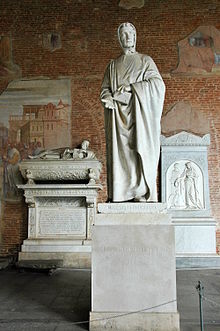Leonardo Fibonacci
 Statue of Fibonacci (1863) by Giovanni Paganucci in the Camposanto di Pisa[lower-alpha 1] | |
| Kamundagan | c. 1170 Pisa,[2] Republic of Pisa |
|---|---|
| Kagadanan | c. Missing required parameter 1=month! , 1250 (edad Error: Need valid year, month, day) Pisa, Republic of Pisa |
| Trabaho | Mathematician |
| Midbid bilang |
|
| Mga magurang | Guglielmo "Bonacci" (father) |
Si Fibonacci (/ˌfɪbəˈnɑːtʃi/;[3] also US: /ˌfiːb-/,[4][5] Italian: [fiboˈnattʃi]; c. 1170 – c. 1240–50),[6] midbid man bilang Leonardo Bonacci, Leonardo kan Pisa, o Leonardo Bigollo Pisano ('Leonardo the Traveller from Pisa'[7]), sarong Italyanong matematiko hali sa Republic of Pisa, kinokonsiderar na pinakatalentadong matematiko sa Tahaw na Panahon".[8]
An ngaran na Fibonacci, na ginibo kan 1838 kan Pranses-Italyano na historyador na si Guillaume Libri[9][10] na pinalipot na filius Bonacci ('aking lalaki ni Bonacci').[11][lower-alpha 2] Pero dawa kan kinaamayan kan taong 1506 sarong notaryo kan banal na Imperyong Romano, sinabi ni Perizolo na si Leonardo bilang "Lionardo Fibonacci".[12]
Pinasikat ni Fibonacci an sistemang numeral na Hindu–Arabic sa kinaban nin sulnopan sa saiyang komposisyon na kan 1202 na Liber Abaci (Book of Calculation).[13][14] Pinamidbid niya man sa Europa an sequence of Fibonacci numbers, na ginamit niyang halimbawa sa Liber Abaci.[15]
Hilingon man
[baguhon | baguhon an source]Mga nota
[baguhon | baguhon an source]Mga toltolan
[baguhon | baguhon an source]- ↑ "Fibonacci's Statue in Pisa". Epsilones.com. Retrieved 2010-08-02.
- ↑ Smith, David Eugene; Karpinski, Louis Charles (1911), The Hindu–Arabic Numerals, Boston and London: Ginn and Company, p. 128.
- ↑ "Fibonacci, Leonardo". Lexico UK English Dictionary. Oxford University Press. n.d. Retrieved 23 June 2019.
- ↑ "Fibonacci series" and "Fibonacci sequence". Collins English Dictionary. HarperCollins. Retrieved 23 June 2019.
- ↑ "Fibonacci number". Merriam-Webster Dictionary. Retrieved 23 June 2019.
- ↑ MacTutor, R. "Leonardo Pisano Fibonacci". www-history.mcs.st-and.ac.uk. Retrieved 2018-12-22.
- ↑ 7.0 7.1 Livio, Mario (2003) [2002]. The Golden Ratio: The Story of Phi, the World's Most Astonishing Number (First trade paperback ed.). New York City: Broadway Books. pp. 92–93. ISBN 0-7679-0816-3.
- ↑ Eves, Howard. An Introduction to the History of Mathematics. Brooks Cole, 1990: ISBN 0-03-029558-0 (6th ed.), p. 261.
- ↑ Devlin, Keith (2017). Finding Fibonacci: The Quest to Rediscover the Forgotten Mathematical Genius Who Changed the World. Princeton University Press. p. 24.
- ↑ Colin Pask (7 July 2015). Great Calculations: A Surprising Look Behind 50 Scientific Inquiries. Prometheus Books. p. 35. ISBN 978-1-63388-029-0.
- ↑ Keith Devlin, The Man of Numbers: Fibonacci's Arithmetic Revolution,A&C Black, 2012 p. 13.
- ↑ Drozdyuk, Andriy; Drozdyuk, Denys (2010). Fibonacci, his numbers and his rabbits. Toronto: Choven Pub. p. 18. ISBN 978-0-9866300-1-9. OCLC 813281753.
- ↑ "Fibonacci Numbers". www.halexandria.org.
- ↑ Leonardo Pisano: "Contributions to number theory". Encyclopædia Britannica Online, 2006. p. 3. Retrieved 18 September 2006.
- ↑ Singh, Parmanand. "Acharya Hemachandra and the (so called) Fibonacci Numbers". Math. Ed. Siwan, 20(1):28–30, 1986. ISSN 0047-6269]
Magbasa pa lalo
[baguhon | baguhon an source]- Devlin, Keith (2012). The Man of Numbers: Fibonacci's Arithmetic Revolution
 . Walker Books. ISBN 978-0802779083.
. Walker Books. ISBN 978-0802779083. - Goetzmann, William N. and Rouwenhorst, K.Geert (2005). The Origins of Value: The Financial Innovations That Created Modern Capital Markets. Oxford University Press Inc., US, ISBN 0-19-517571-9.
- Goetzmann, William N., Fibonacci and the Financial Revolution (October 23, 2003), Yale School of Management International Center for Finance Working Paper No. 03–28
- Grimm, R. E., "The Autobiography of Leonardo Pisano", Fibonacci Quarterly, Vol. 11, No. 1, February 1973, pp. 99–104.
- Horadam, A. F. "Eight hundred years young," The Australian Mathematics Teacher 31 (1975) 123–134.
- Gavin, J., Schärlig, A., extracts of Liber Abaci online and analyzed on BibNum [click 'à télécharger' for English analysis]
Panluwas na takod
[baguhon | baguhon an source]- "Fibonacci, Leonardo, or Leonardo of Pisa." Complete Dictionary of Scientific Biography. 2008. Encyclopedia.com. (April 20, 2015). [1]
- Fibonacci at Convergence
- Fibonacci (2 vol., 1857 & 1862) Il liber abbaci and Practica Geometriae Archived 2019-12-08 at the Wayback Machine. – digital facsimile from the Linda Hall Library
- Fibonacci, Liber abbaci Bibliotheca Augustana
